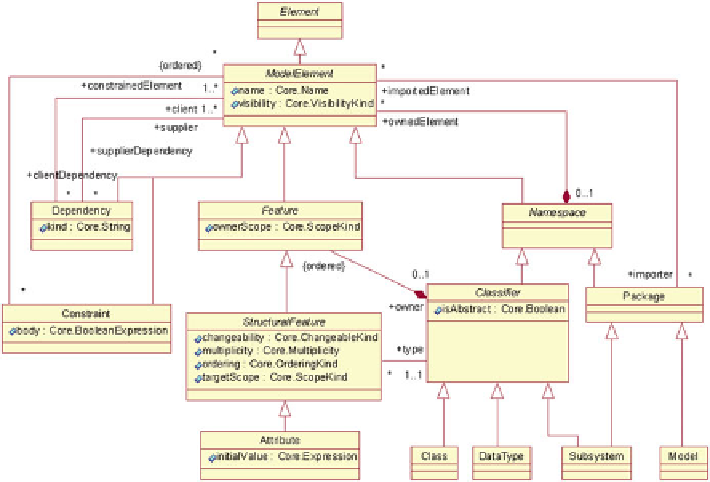Database Reference
In-Depth Information
Fig. 12.3 Class diagram of CWM Core package
We cite [PCTM03]:
At its heart, the
Core
package provides for the description of things that have structure.
Structured things include familiar computer system objects like relational database tables,
records in a file, and members of Online Analytical Processing (OLAP) cube dimensions. In
UML terms, the individual items of a thing's structure are called
features
and are
represented by the
StructuralFeature
class. For example, the features of a relational table
are the columns in the table; for a record, they are an ordered list of the record's fields.
CWM allows for nonstructural features as well; they are described by the
Behavioral
package. The
Attribute
class represents structural features that can have an initial value.
Features are owned by
Classifiers
through a composite association. A classifier is a
thing that has a structure; for example, both records and relational tables are types of
classifiers. The notion of classifier is very similar to the idea of type used in modern
programming languages.
Integer
and
character
are simple, frequently encountered pro-
gramming language types; they are classifiers in CWM, but they have no features.
Address
, in contrast, is a compound type (classifier) whose features might consist of
street, city, state,
and
zip code.
In the same way, a relational table is a classifier whose
features are its columns, and a record is a classifier whose features are its fields. Note that
StructuralFeatures
are owned by one classifier and are related on another classifier. The
former is the
StructuralFaeture
's owner, and the latter is its type. A
StructuralFeature
cannot have the same classifier as both its owner and its type.
The class named
Class
represents classifiers that can have multiple instances. So,
Tables are really instances of
Class
because they can contain multiple data rows. In contrast,
the
DataType
class represents classifiers that have only one instance;
integer
and
character
are instances of
DataType.
Although
Namespace
s have no attributes, they are critically important because they
ensure that individual objects can be uniquely identified by their names. Consequently,

